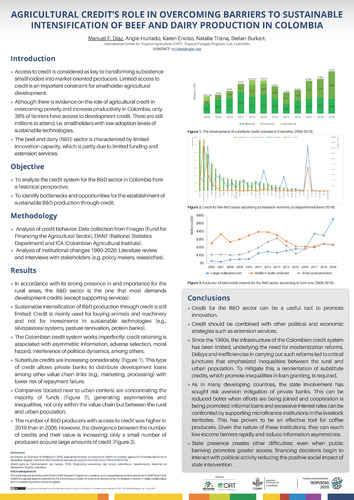Agricultural credit’s role in overcoming barriers to sustainable intensification of bovine livestock production in Colombia
The positive effects of agricultural credit in the modernization of developing economies are well documented and range from increased productivity and reduced vulnerability to seasonality and significant multidimensional poverty reduction. However, credit placement in the Colombian agricultural sector is still low and only 5% of agricultural credits have investment motivations. On the other hand, the sector has been experiencing a significant growth and diversification of credit lines, including some focused on rural women and youth, and others on promoting sustainability in livestock production. This study attempts to analyze the role of agricultural credit in the upscaling and consolidation of sustainable intensification options for bovine livestock production systems. For this, the study adopts a qualitative approach, based on semi-structured interviews and focus groups discussions with key stakeholders (e.g. representatives of financial institutions, policy makers, producer associations), as well as a meta-analysis of recent impact evaluation studies of agricultural credit. Results indicate the presence of structural and market failures. First, the granting of credits has not always corresponded to the spirit of the promotion programs but to political interests and motivations. Second, current credit requirements cause conflicts with producer realities, such as land titles and access to property, and limit accessibility leading to a promotion and proliferation of informal credit structures, with baneful effects on the rural poor. Third, rural poverty limits the effective demand for credit, reducing the incentives for the expansion of private financial services in rural areas. And fourth, lower investment in technology in rural areas, which is related to a) missing recognition of the benefits of an innovation due to deficiencies in extension services; b) information asymmetries on the rates of return of new investments and technologies; and c) high transaction costs. The study proposes elements for the mitigation of these failures, such as a limitation of substitute credits (used for purposes other than agricultural activities) and their reorientation towards sustainable intensification (e.g. with silvo-pastoral systems and appropriate extension services), as well as the promotion of cooperative credits, among others.

